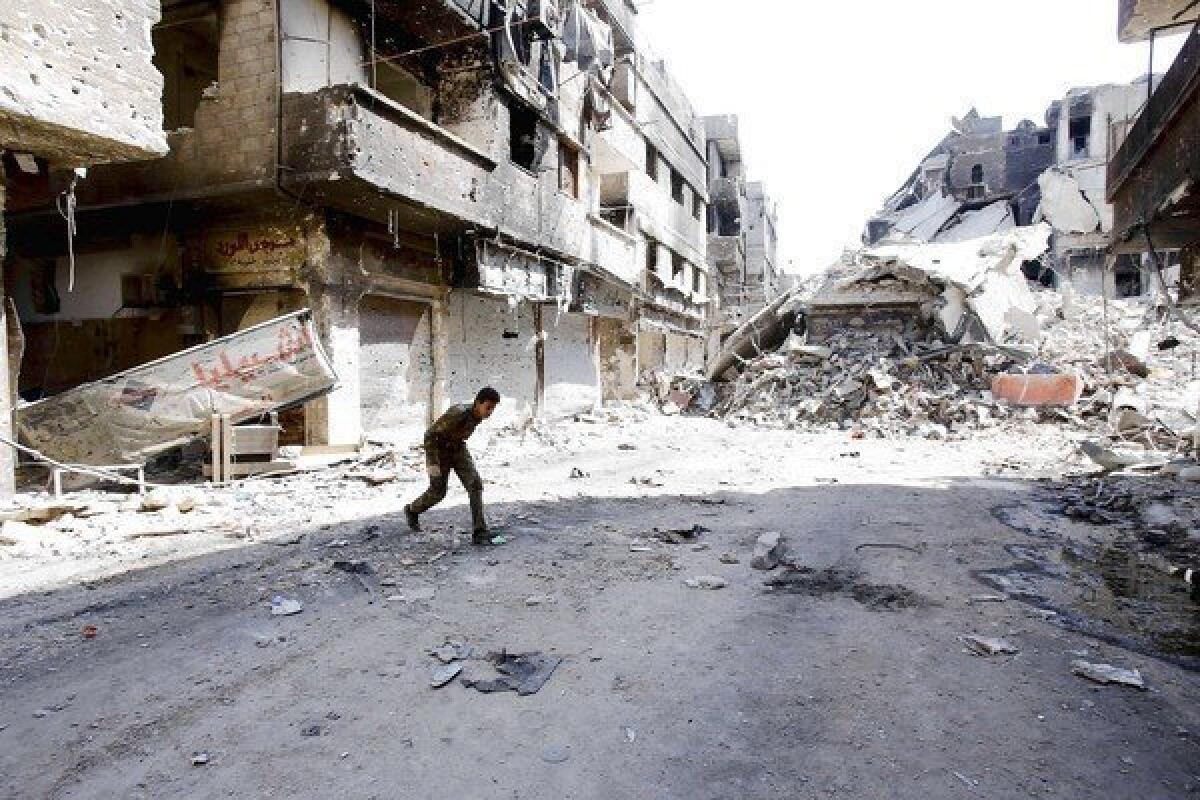Syria’s chemical stockpile easy to find, hard to get to

- Share via
BEIRUT — U.S. officials seldom conceal their contempt for Syrian President Bashar Assad, but Secretary of State John F. Kerry credited Assad’s government Saturday with a not-insignificant achievement: Safeguarding the nation’s chemical armory in the midst of a raging civil war.
That fact, Kerry emphasized, helped make possible an “ambitious” U.S.-Russian plan to eliminate Syria’s substantial chemical weapons stores.
“One of the reasons that we believe that this is achievable is because the Assad regime has taken extraordinary pains in order to keep control of these weapons,” Kerry told reporters Saturday in Geneva after outlining the U.S.-Russian initiative. “They have moved them, and we know they’ve moved them. We’ve seen them move them. We watched this. And so we know they’ve continued to always move them to a place of more control.”
That fact, Kerry said, would help answer one of the key outstanding questions: How to gather and destroy a vast chemical arsenal, even as fighting rages.
“This is sort of the silver lining, if you will,” Kerry said. “If the Assad regime is prepared to live up to its word, we should not have a problem achieving access to their sites.”
According to the plan’s bold timetable, inspectors should be entering Syria by November and the nation’s chemical stockpile should be destroyed by mid-2014. But many are skeptical.
At least 40 sites in Syria are associated with the nation’s chemical weapons program, and about half have significant amounts of materiel, a U.S. official told reporters Saturday in Geneva. Reports have indicated that some chemical stockpiles are situated around Damascus, the capital, while others may be found to the north, in Homs, Hama and Aleppo provinces, and to the west in coastal Latakia.
Still, even with the materiel concentrated in government-held zones, access will be problematic. No long-distance road in Syria is completely safe. And Syria’s armed rebels, who had been hoping for U.S. airstrikes that would degrade Assad’s forces, have generally rejected the U.S.-Russian deal, raising the possibility that chemical weapons inspection personnel could come under attack by opposition gunmen.
These days, the central core of Damascus is under extremely tight security, with military checkpoints every few blocks. Still, mortar shells launched from rebel-held suburbs regularly explode inside the city limits, killing civilians. Car bomb attacks are a regular threat.
Chemical weapons depots are unlikely to be in the densely populated center. Such facilities are more likely to be situated in the capital’s rambling outskirts, where vulnerability to rebel attack is much greater.
Previous U.N. inspection teams have entered Syria in convoys from neighboring Lebanon. The hourlong drive from the border along the heavily guarded highway to Damascus is relatively secure, with numerous military checkpoints. But rebel forces are nearby and roadside ambushes are common. Government checkpoints are frequent hit by rebel attacks.
From Damascus, the major route north to Homs cuts through the now-infamous eastern Ghouta area, a rebel stronghold that was the site of some of the chemical attacks on Aug. 21 that U.S. officials believe were carried out by Assad’s forces. Drivers routinely speed up on the highway through the battered districts of Jobar, Qaboun, Harasta and Duma, all still battle zones. Gunfire is frequent and smoke rises from scorched buildings. Abandoned cars along the road point to the ease with which waiting snipers can pick off passing traffic.
The convoys of previous teams of U.N. inspectors dispatched to Syria, including chemical specialists investigating the Aug. 21 attack, have been fired on, though no U.N. personnel have been seriously injured.
The highway to Homs has little traffic nowadays and offers ample cover for snipers. Bullet-pocked buildings and the crackle of gunfire mark the turnoff for the embattled city of Yabrud, a rebel stronghold about halfway between Damascus and Homs.
Homs itself is a patchwork of government-controlled neighborhoods, rebel-held districts and mostly abandoned areas such as Baba Amr, once a symbol of the Syrian insurgency but now largely a rubble-filled ghost town. Any chemical weapons stored in Homs are presumably held in heavily guarded bases. But entering and exiting the city is always a hazardous enterprise.
Farther north, toward Hama and Aleppo, the route becomes even more perilous. Loyalist militiamen and soldiers wave off motorists seeking to take the main route north from Homs to Hama, advising them that it is too dangerous. On two recent trips, the route appeared deserted, an abandoned highway.
The route from Homs west over the coastal range to the Mediterranean is relatively clear. However, as elsewhere, insurgent fighters could pose a threat. The main road from Homs to the coastal city of Tartus offers a distant view of the celebrated Crac des Chevaliers, once a medieval Crusader fortress, now a strategic rebel bastion.
More to Read
Sign up for Essential California
The most important California stories and recommendations in your inbox every morning.
You may occasionally receive promotional content from the Los Angeles Times.










